Google’s AI Overviews (AIOs) don’t play entirely by traditional SERP rules.
More so, ranking high on page one doesn’t guarantee you’ll appear in AI Overviews. And while old-school SEO still matters, it needs a modern twist to stay visible.
This article will explain essential things to know about AI Overviews and the strategies to rank in them, including:
- Understand AIO search intents
- Build topic authority with topic clusters
- Build brand mentions and more
We also asked a few SEO experts about their best strategies for ranking in AI Overviews and collated their responses.
Let’s break down how AIOs work and what you must do to get cited inside them.
Table of Contents
How Google AI Overviews Work
Before deep diving the strategies, we need to answer two questions here to understand how this Google AI Overviews works:
- What AI Overviews look like
- How Google genrates AI Overviews
What AI Overviews Look Like
AI Overviews are Google’s AI-generated summaries that provide quick, multi-source answers at the top of search results, using information from various web pages.
It includes the source links on the right side of the snapshot for users to learn more.
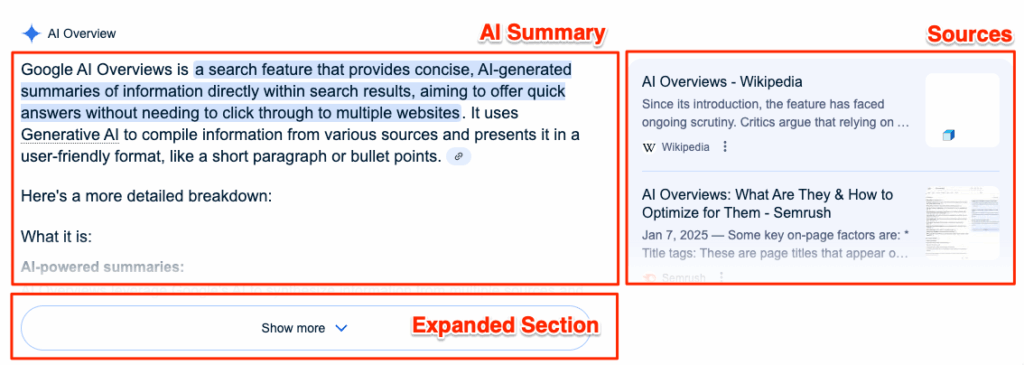
AI Overviews appear in different components:
- Simple list
- Image list
- Paragraphs of text
- Hero Images

NOTE: With thruuu AIO Analyzer you can preview any Google SERP, including AI Overviews, without the need for a VPN. It is really useful if you work on several international markets.
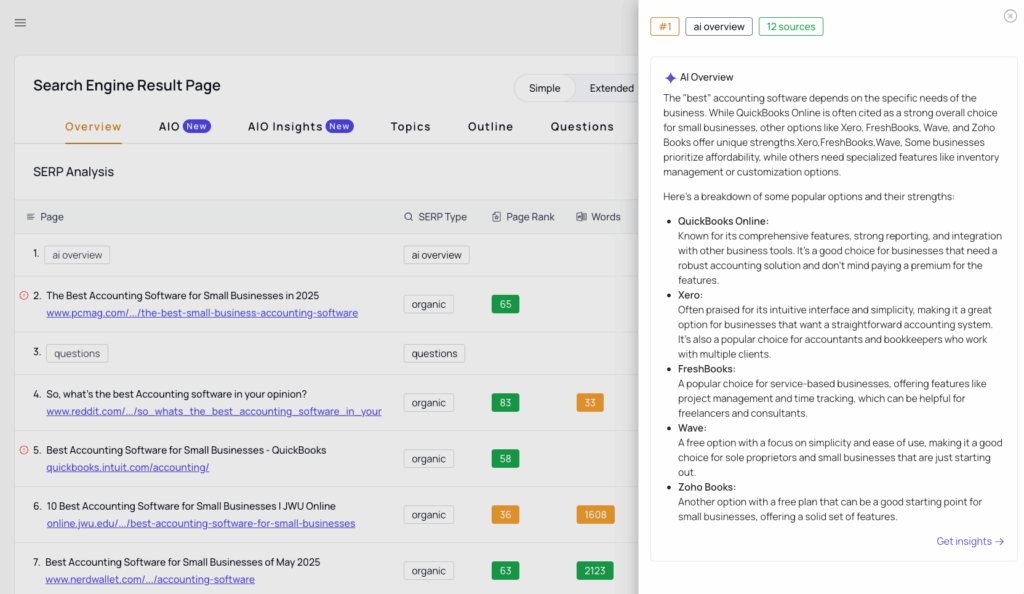
How Google Generates AI Overviews
When you search for something like “best keyword clustering software”, Google breaks your question into multiple sub-queries. This process is known as query fan-out.
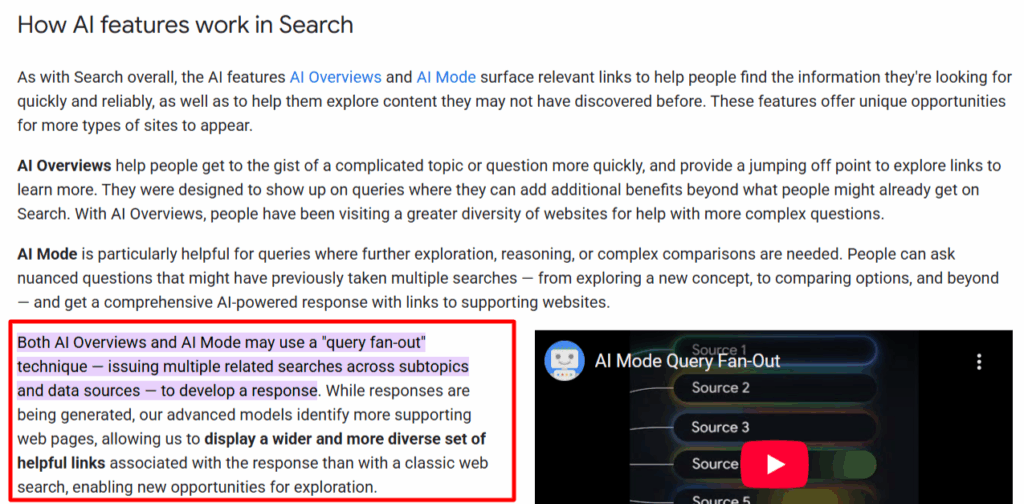
In his article on How AI Mode Works, Mike King calls it “a reformulation into a constellation of other questions, some obvious, some implicit, some predictive.”
So if we take our example, Google AIO might break down the query into sub-queries such as:
- What is keyword clustering software?
- Top features of keyword clustering tools
- Best keyword clustering software for SEO
- Keyword clustering software comparison
- How to use keyword clustering software and more
It also analyses different content types:
- Listicles
- Product comparisons
- Niche-specific guides
- Help docs
- Community forums
- Even YouTube videos
Google isn’t just looking for one good answer. It’s trying to predict every angle you might ask next, and that’s what gets surfaced in AI Overviews.

Google also uses several personalization factors to power this reasoning chain. Think of your search history, location, device type, language preferences, and more.
That’s why sometimes you see content that seems unrelated to the main search in the AIO sources. Google foresaw related searches to make the summary more comprehensive.
Let’s quickly decipher a popular myth around AI Overviews and SERP rankings before we move into the strategies for ranking in AI Overviews.
The Connection Between AI Overviews and SERP Rankings
Google uses different algorithms to cite URLs in AI Overviews and rank pages on SERPs.
In AIOs, Google pulls passages from various sources answering the main query and all the sub-queries generated by the “fan-out” process.
Then it will compare each passage or text segment to determine the best ones. Finally a summary is generated from the best sources using Google LLM, Gemini.

A key difference between ranking in AIO and getting cited versus ranking in the classic organic listing is that in AIO, Google judges you on a passage level (or paragraph level if you prefer), whereas in the classic listing, it judges the entire page.
This is why ranking on the SERP first page doesn’t guarantee a brand mention in AI-generated summaries or citations in AIO sources, as Google will pick the best part of the pages.
See the AI Overview and organic results for the keyword “best accounting software for small businesses.”
Capterra isn’t ranking on Google’s first page for that search query but is cited in the AI Overview. It is likely that Capterra provides key information in one passage of its article.
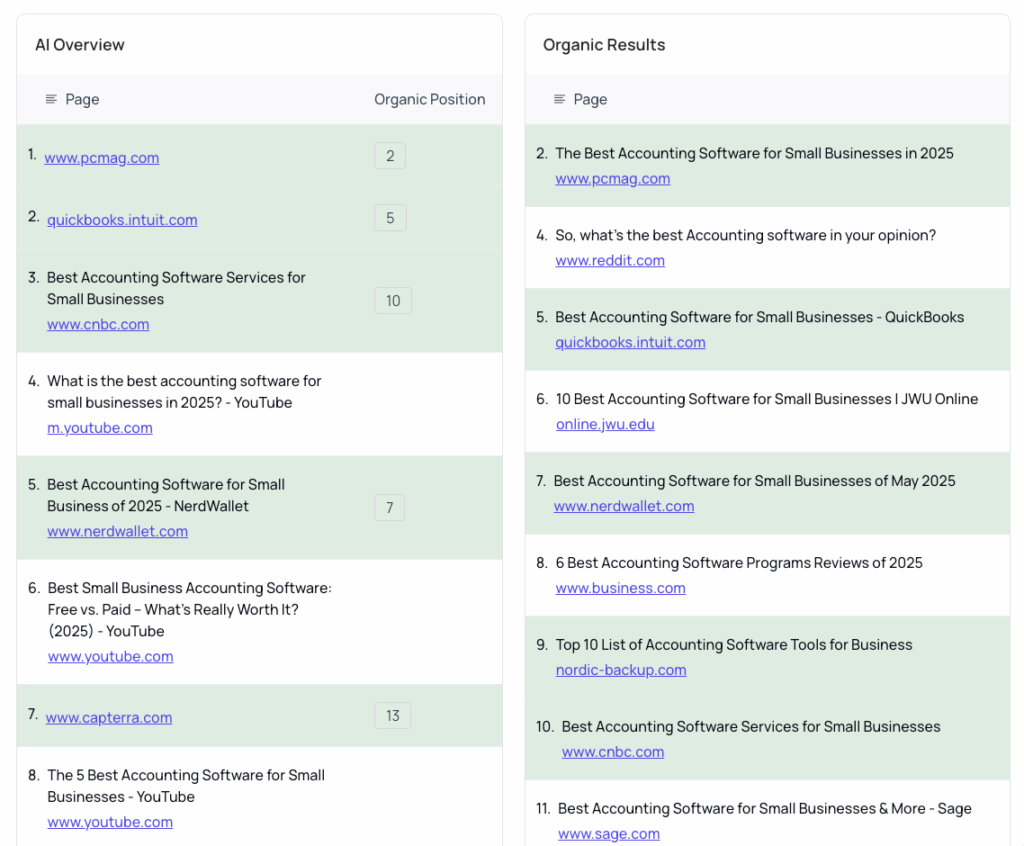
Note: You can further compare AI Overviews and organic results with the thruuu AIO Analyzer.
The tool dives deeper into the similar headings, questions, and topics of URLs from the AI Overview and the organic search results to help you understand the key differences and spot unique topics that only appear in AIO.

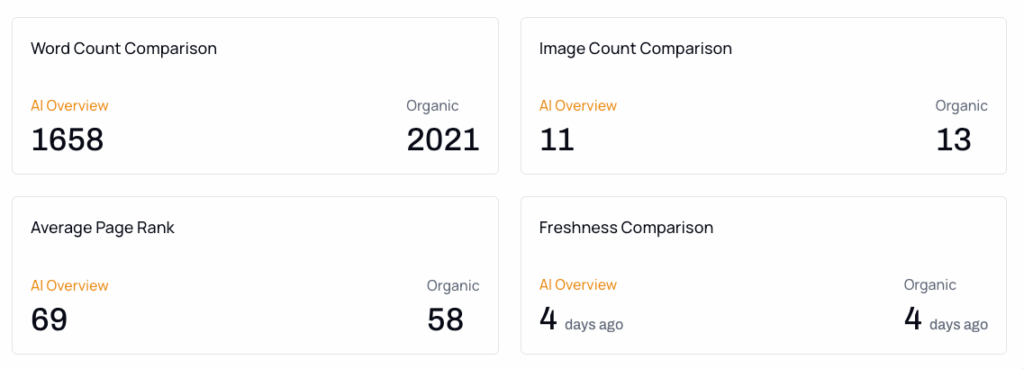
Strategies to Be Visible in AI Overviews
We asked thruuu users to share their most effective strategy for ranking in AI Overviews.
Most people see content relevance and topical authority as the primary ranking strategy.
These factors are fundamental, but there is more to it.
Read on to learn the strategy to build real estate on AI Overviews:
1. Analyse the SERP and AI Overviews
SERP analysis is foundational to understanding AI overview patterns and securing a spot in them.
This analysis also helps you understand:
- The content format included in the AI Overview
- If Google includes multimedia like images, videos, or embedded links to further sources
- The source pages Google references in the AI Overview
- The content depth and topical relevance
- How Google breaks down the query into related sub-queries
- The brands mentioned
- The intent behind the search query, and more
However, analysing the AI Overview for each search query can be brain-straining.
Let thruuu’s AIO Analyzer handle the grunt work while you focus on strategy, not spreadsheet therapy.
In seconds, the tool shows your keyword AI Overview summary, sources, mentioned brands, key topics, comparison with the organic search result, and more.
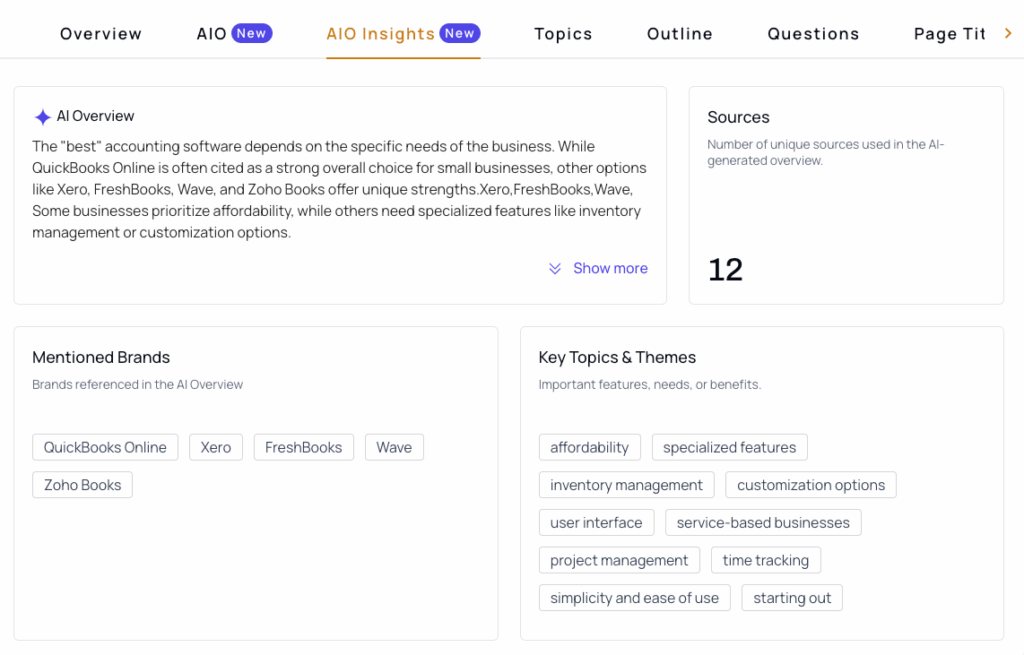
2. Understand AIO Search Intents
Let’s get back to Google’s query fan-out strategy for generating AI Overview summaries. A single search query can pull in sources from different angles and search intents.
For example, Google’s AI Overview for “best CRM in 2025” sourced its answers from 25 sources including:
- Informational search intent page such as “CRM Lead Management Guide“
- Commercial search intent pages such as “Best CRM Software of 2025” and “Best Alternatives to XXX“
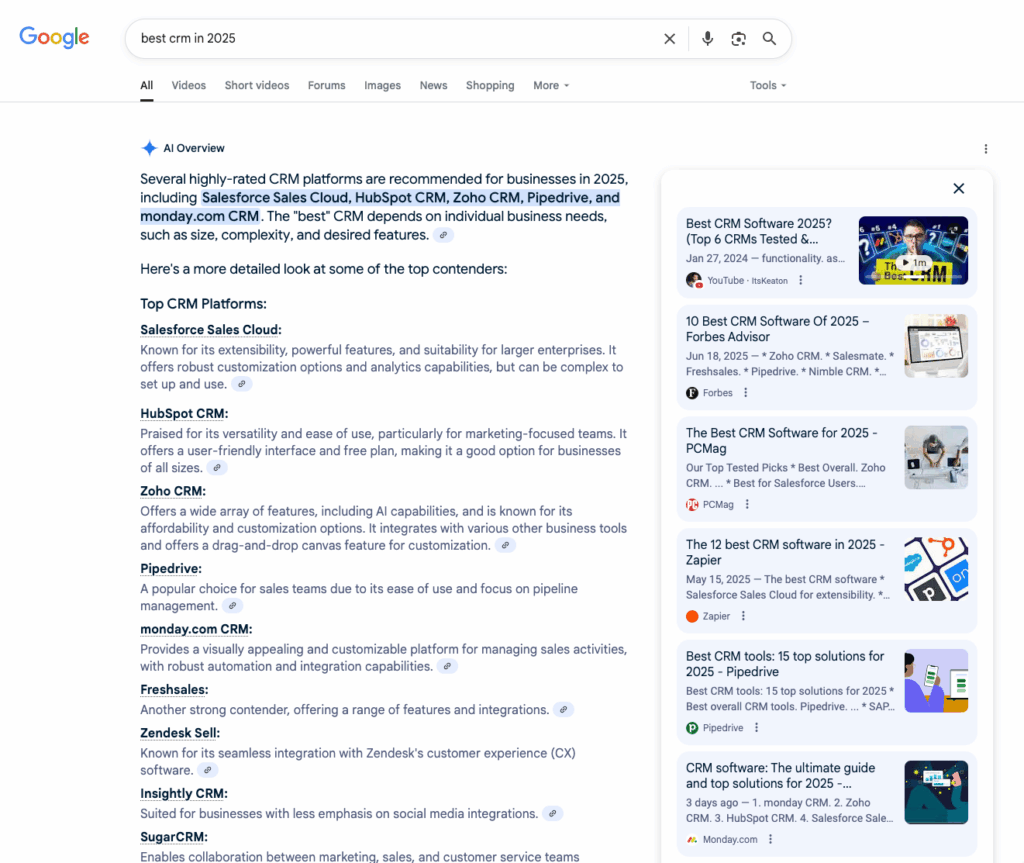
What’s even more interesting is how AI Overviews explore related product categories and niche contexts to select sources.
For example, they might pull from categories like:
- Contact Management Software
- Sales Automation Platforms
- WordPress CRM Plugins
And also target niche segments such as: Ecommerce, Startups, Small Businesses, or even Beginners.
But most of these pages share one thing in common: a specific text section that lists or mentions tools.
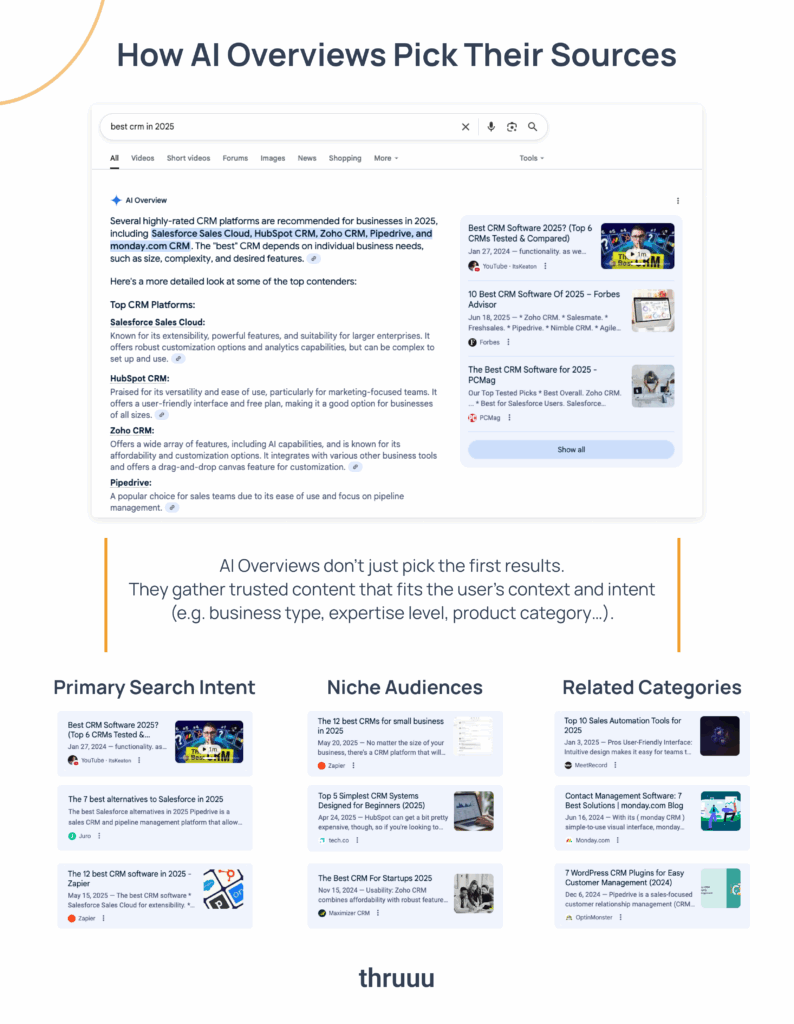
What’s your job now? Build content that addresses all these search intents.
Think like Google: cover the complete conversation, not just the headline query.
How?
3. Build Topical Authority with Topic Clusters
Topic clusters help you build topical authority by organising content around a central topic, signaling to search engines that your site deeply covers the subject and is a trusted source.
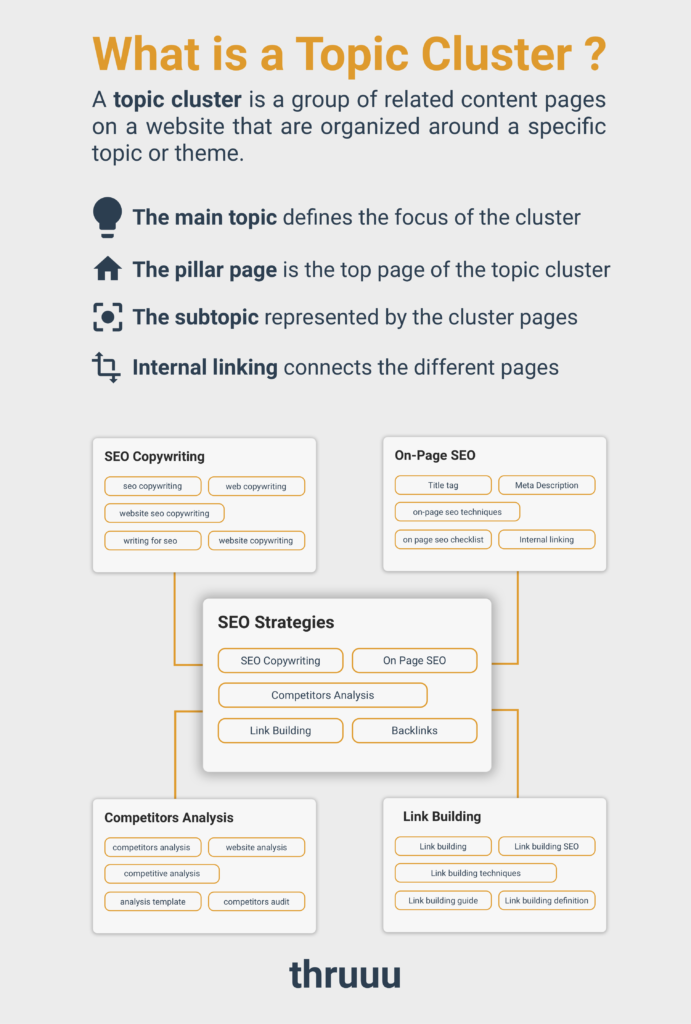
You should create topic clusters on your target topics’ buyer stages to establish your site as an authority and build real estate on AI Overviews.
We mean target:
- Top-of-the-funnel (TOFU) topics, e.g., what is… How does… Beginner’s guide to… etc
- Middle-of-the-funnel (MOFU) topics, e,g., Comparison & alternatives, How-to & guides, Features & benefits, etc
- Bottom-of-the-funnel (BOFU) topics, e.g., Product comparisons, Use case specific, Decision-making & buying, etc.
For instance, we rank on AI Overviews for topic clustering (and on the classic organic listing) because we’ve become the go-to site for that topic.
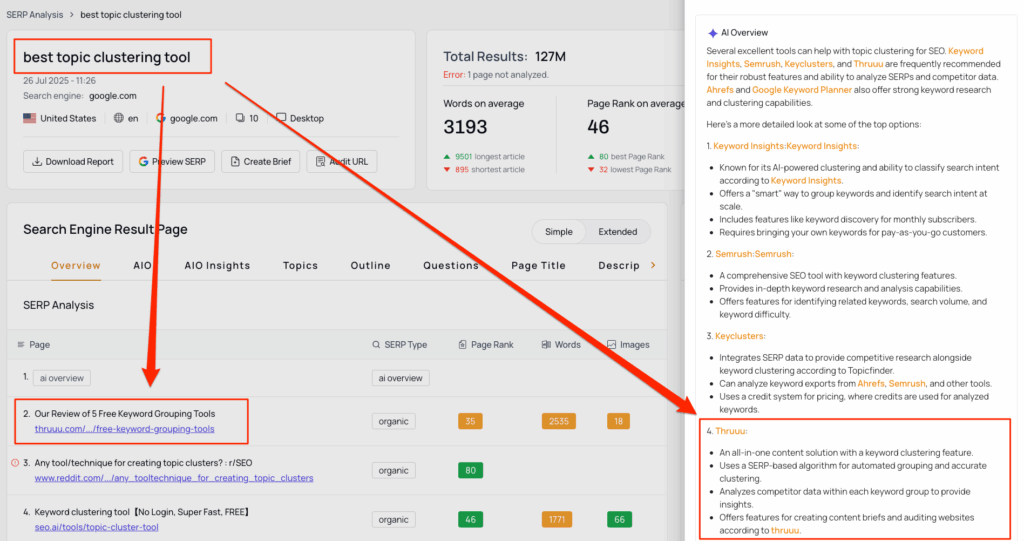
We have a solid pillar page and cluster pages that answer key audience questions on different aspects of the topic.
See how it looks and deep dive into topic cluster strategy for SEO.
As Google’s AI Overviews break down queries into sub-questions, creating a cluster of content around a main topic increases your chances of surfacing in AI-driven search results.
Do you want to build topical authority through topic clusters?
We have built the best keyword clustering tool. This tool automatically groups a large set of keywords based on search intent by identifying similarities in the SERP.
Discover how thruuu keyword clustering works in this video.
4. Create High-Quality, Well-Structured Content for AI Readability
Google recently shared the top ways to ensure your content performs well in its AI experiences on search.
The documentation started with a fallback to their long-time advice on creating content that satisfies visitors’ search intent.
“As a site owner, publisher, or creator, you may be wondering how to best succeed in our AI search experiences, such as AI Overviews and our new AI Mode. The underpinnings of what Google has long advised carry across to these new experiences. Focus on your visitors and provide them with unique, satisfying content. Then you should be well-positioned as Google Search evolves, as our core goal remains the same: to help people find outstanding, original content that adds unique value.”
They continued with a list of other factors to rank in AI search features. See the first factor stated:

Google’s emphasis on creating helpful content for people shows that this factor carries much weight.
Stephanie Trovato of Big H Content shared the type of content that will gain presence in AI Overviews.
She said,
“Create content that brings something new—your experience, a strong opinion, customer insight, real data, and more. Content that has depth, a unique perspective, and is useful. That’s what AI Overviews want to link to.”
Also, make your content easy for humans to read and for LLM. We mean:
- Use headers consistently
- Break down complex points into bullet points, numbered lists, or tables
- Using clear and concise language for readability
- Keep paragraphs short (2–4 lines max)
Keshi Ile, an AI optimization consultant, recently shared how he increased his client’s ranking in AI Overviews.
His strategy prioritized well-structured content for AI readability among other factors.

Remember that Googlebots analyze not only your page but every passage of your page. Therefore, your optimization strategy must happen on the paragraph or section level.
In short, treat every section as if it’s the only thing Google will read.
Also, create more context-rich bottom-of-the-funnel content.
In our AI ranking strategy survey, a thruuu user, Nicole Kolesar, CEO of Practiwrite, said his primary strategy for ranking in AI Overview is by “Addressing REAL audience concerns naturally in your content and tying those pain points to your product/service solutions.”
Prioritize more bottom-of-the-funnel content that emphasizes your audience’s problems and show how your product/service solves them.
This content type performs well for brand mentions in AI Overviews (we’ll share more on this later).
We have discussed this with Lashay Lewis in a webinar about ranking BOFU content in LLM.
5. Include Information Gain
Let’s go deeper into the previous point. Google values new, helpful information it hasn’t seen a thousand times before.
As Kevin Indig says in his AIO optimization guide.
“For AIOs, we can tweak our content to match the AIO answer or give a better one, but reflecting ‘useful’ information in the search query context is much more important than the exact wording.”
Follow what we call the 80-20 principle for writing blog posts. This principle states that 80% of your content should follow the trend while 20% must be unique, bringing new insights.
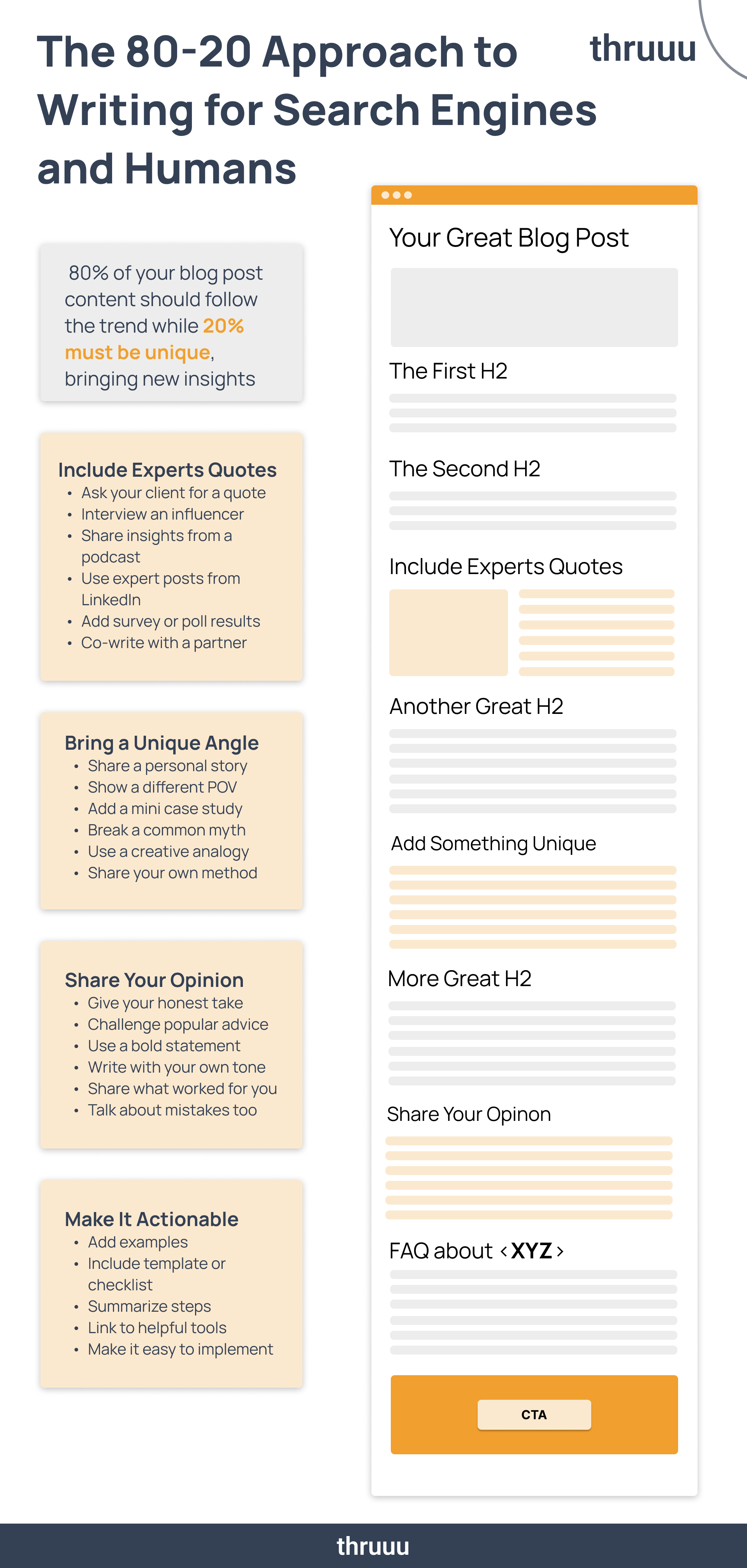
Hanns Kronenberg shared an insight about Claude, but we could assume that Google follows the same practice.

To be cited or linked, your content must:
- Answer complex or up-to-date questions.
- Contains a unique value not in LLM’s training data
- Provide simple information with high readability
How to bring information gain?
- Share original data
- Include industry-specific examples
- Answer evolving questions
6. Build Brand Mentions
Brand mention is the new backlink.
Ahrefs’ latest study of 75,000 brands proves that brand-related metrics are stronger indicators for showing up in AI overviews than traditional backlinks.
Here are the top five factors from the study:
- Branded web mentions
- Branded anchors
- Branded search volume
- Domain Rating
- Number of referring domains

As you can see, the top three are all brand-related.
You need to build a presence across every discovery channel. We mean creating recognition across channels where your ICP spends time.
You must work your brand presence everywhere and be mentioned on social media platforms, podcasts, webinars, community forums, videos, and more.
We are in a multimodal world.
More so, SEO is now Search Everywhere Optimization.
It’s all about E-E-A-T and brand reputation.
Jules Davies, founder at Scalerrs, recently said that branded search is the secret E-E-A-T signal no one talks about. And it’s the only way Google measures a brand’s reputation.
Moreover, branded search doesn’t come from traditional SEO strategies, but by increasing brand mentions.
Here’s how he puts it:
“When branded search volume goes up, organic clicks follow. It’s one of the clearest trust signals you can send, and it impacts rankings.
And here’s the part most SEOs miss—Branded search doesn’t come from SEO but everything else.
Think:
- Word of mouth from real users
- Reddit threads where your product gets name-dropped
- YouTube tutorials or comparisons
- Podcasts featuring your founder/brand
- Blog or newsletter mentions
- LinkedIn posts from personal branding
That’s omnichannel marketing in action. It means showing up consistently across the platforms your audience already uses, so when they’re ready to search, they already know your name.
And that’s how you build E-E-A-T that moves rankings.
By showing up early, often, and in the right places.”
And here’s an explicit infographic from Jules on how to build brand mentions organically.

Also, you should get your brand cited in authoritative third-party sites that mention your competitors, and AI Overviews often link to them.
Gaetano Nino DiNardi, a growth advisor, shared a case study on Justin Norris’ podcast about how brand mentions in authoritative third-party websites increased his client’s brand visibility in LLMs’ answers.
He said,
“To appear in LLM answer recommendations for bottom of the funnel/high intent/high competition prompts, your brand must be present on relevant third-party listings and directories (whether it’s “pay to play” or not).
My client was mentioned in authoritative sites like PCMag, Investopedia, Tech Radar, Security.org, cnet.com, and more for a bottom-of-the-funnel keyword. Interestingly, AI Overviews’ summary for that search query featured my client but cited those authoritative sites.”
Lastly, create more brand-related articles, product comparisons & alternatives, best of, brand story or case study, industry roundups featuring brands, brand-specific FAQs, and more. This content type increases your brand mentions and site citations in AI Overviews.
Just as Chris Long, VP of Marketing at Go Fish Digital, says,
“For OpenAI, what we’ve found is that listicle articles tend to perform quite well for brand mentions. Creating your article can give your brand power to influence the response.”
To increase your brand mentions:
- Build a presence across every discovery channel
- Get your brand cited in authoritative third-party sites
- Create more brand-related content
7. Leverage YouTube Videos
AI Overviews often cite YouTube videos in their summaries.
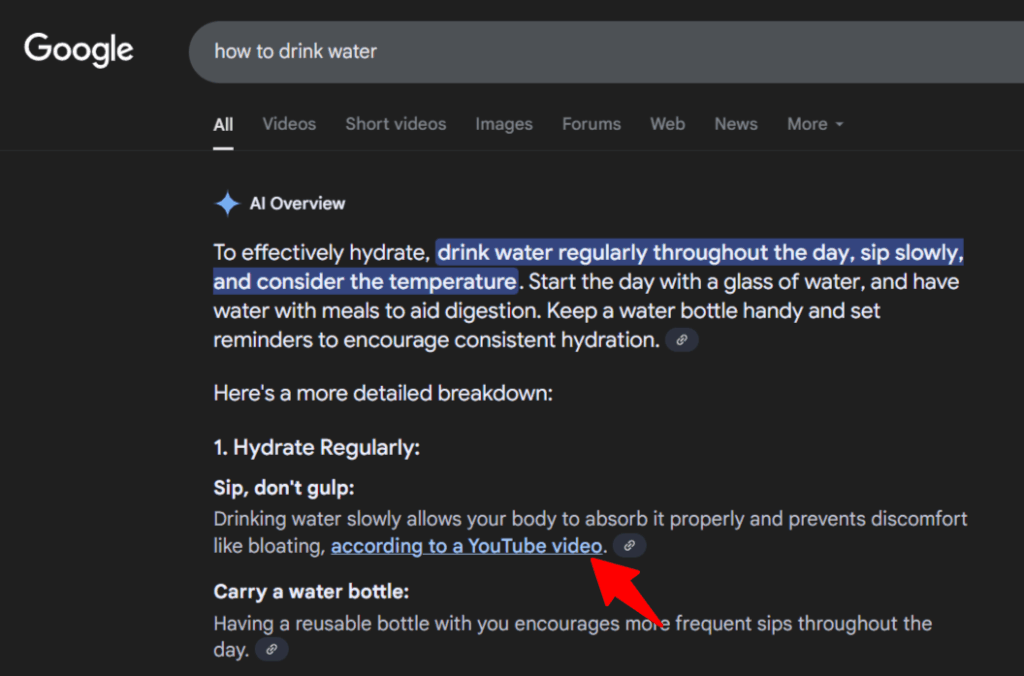
Kevin Indig performed the most extensive analysis of AI Overviews with over 546,000 rows of data spanning 12 million domains. According to his study, the most cited site in AIO is YouTube.com.

The action plan? Diversify your content strategy plan into video creation and repurpose your blog posts into YouTube videos.
To go faster, you can use a free ai video generator to help you to produce your video content without any technical skills required.
Also, increase your brand mentions in popular YouTube creators’ videos. It strengthens your brand presence.
8. Optimize Your Website for Technical SEO
A good technical SEO health makes it easy for Googlebot to crawl, index, and consider your content in AI Overviews.
Adhere to the following technical requirements:
- Ensure your robots.txt file is correctly configured, allowing search engines to crawl essential pages.
- Implement relevant schema markups such as Article schema, FAQ schema, HowTo schema, etc
- Optimize for a fast page load speed
- Prioritize mobile-first design
- Ensure your sitemap is up-to-date and includes all relevant pages.
- Ensure your pages are findable through internal links
9. Track Your Visibility in AI Overviews
Maintaining visibility in AI Overviews is crucial as they continue to shape how Google presents search results to users.
However, you must track your presence in this SERP feature to know where your pages are cited, where to focus your efforts, and the strategies to improve your chances of being featured.
You need visibility on:
- Where is your brand cited?
- Are your competitors mentioned, but not you?
- Which types of content consistently get pulled into the AIO?
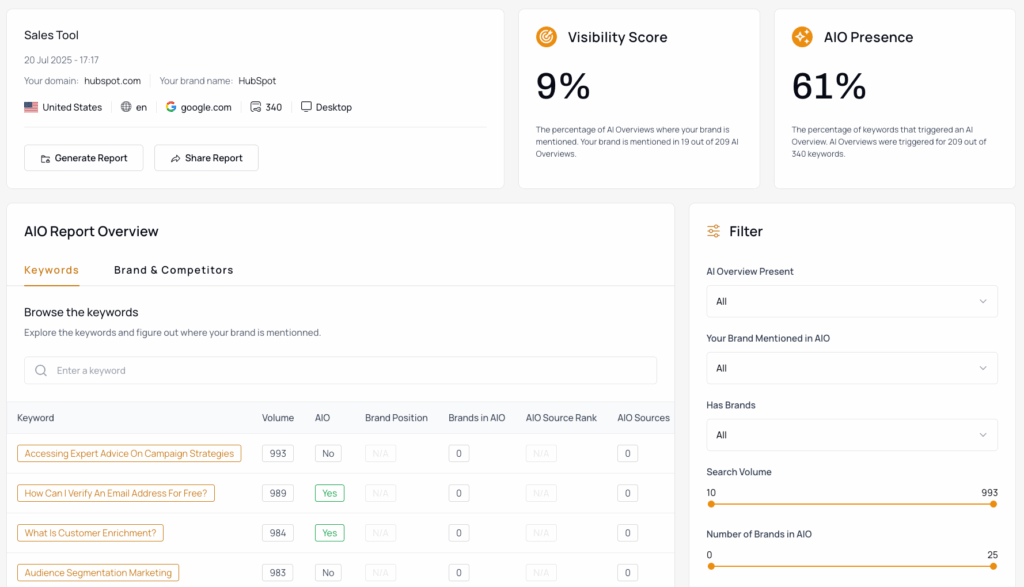
With thruuu’s AI Overview Monitoring Tool, you can:
- Monitor where your brand and domain appear across hundreds (or thousands) of keywords
- Identify which pages are cited and which aren’t
- Benchmark against your competitors’ presence
- Spot “visibility gaps” where your content helps generate the answer, but your brand isn’t mentioned
“AIO Visibility Gaps” opportunities are low-hanging fruit.
If your content is already being used to generate the AI Overview, a few small adjustments might be all it takes to get your brand mentioned directly in the summary.
With the thruuu AIO Monitoring Tool, you can easily identify these gaps by applying smart filters:
- Keywords that trigger an AI Overview
- Keywords where your brand is already mentioned
- Keywords where your website is used as a source
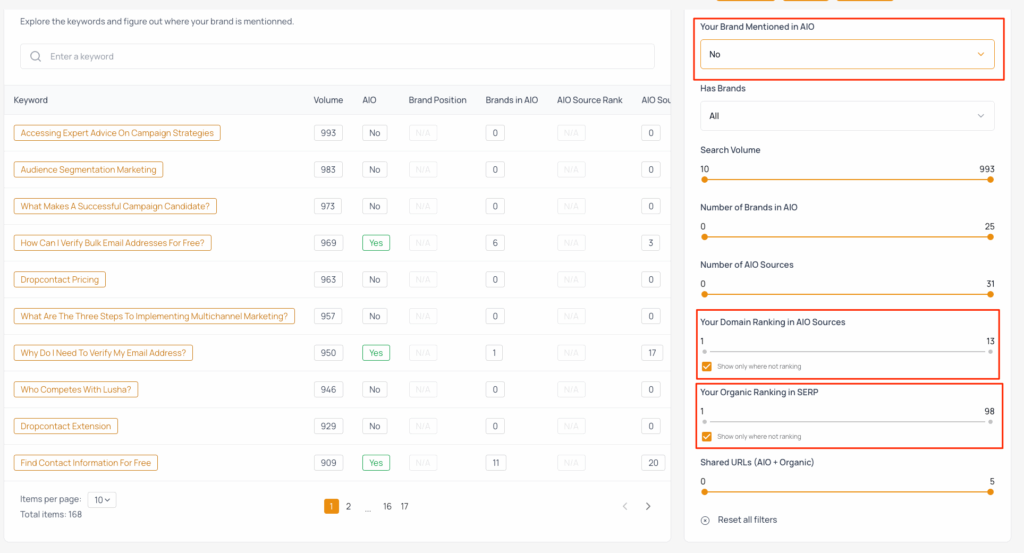
Focus on the ones where your content contributes but your brand is invisible. These are high-leverage opportunities to improve visibility with minimal effort.
AIO Visibility Is the Next SEO Challenge
Ranking in AI Overviews is not only about traditional SEO tactics. It’s about aligning your content with how AI systems interpret value.
That means creating clear, structured content that addresses specific user needs and use cases.
Ready to See Where You Stand in AI Overviews?
With thruuu’s AIO Monitoring Tool, track where you’re cited, spot brand visibility gaps, benchmark competitors, and uncover quick wins to boost your presence in AI Overviews.
